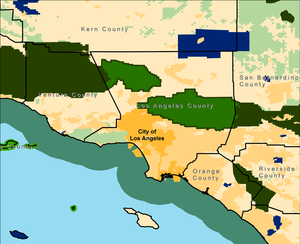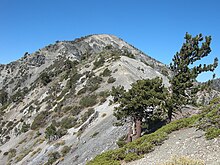Angeles National Forest
Two of these also extend into neighboring San Bernardino National Forest: Early Native American cultural sites in the inland mountain regions corresponding with the Angeles National Forest are sparse, Radiocarbon dates of 7675 and 7600 years Before Present (BP), taken from a cooking feature in one of the northern drainages of the San Gabriel Mountains, are the oldest known from the central Transverse Ranges.
Early material culture indicates extensive use of grinding implements to process small seeds, supplemented by hunting activities.
A Late Period (800 BP to AD 1769) proliferation of sites within the Angeles National Forest indicates a marked increase in regional population.
Greater regional interaction is marked by an increase in non-local materials, indicative of widespread interregional trade networks.
The first reported European contact for the area of the Angeles was in 1769 when the expedition of Gaspar de Portola traveled through the neighboring valleys on his way to Monterey.
In the first two decades of the 19th Century, the Mission System drew in large numbers of Indian neophytes for baptism, completely changing the cultural landscape of the area.
A number of subordinate Missions, or Estancias, were built with native labor as outposts to serve as mission-affiliated ranchos, overseeing localized operations.
The Spanish Missions generally occupied the lands in the lowlands but relied heavily on the mountains for water, building supplies, and game.
By 1800, local Native American traditional cultural lifestyles of had largely disappeared due to devastating European influences, including diseases and incorporation into the Mission System.
Although the mountains were honeycombed with quartz veins, and a host of small mines were gouged out of the slopes in an attempt to strike gold, many of the ventures were inactive by 1896.
Don Benito Wilson, in 1864, built a road into the Forest to harvest wood for fence posts, wine barrels, pickets and shingles.
In 1891, preliminary work began on an electric cable incline railway from Rubio Canyon to Echo Mountain, a feat never before attempted in the world.
Professor Thaddeus S. C. Lowe, an energetic entrepreneur who had garnered fame in the Civil War by ballooning for the Union Army, undertook the venture.
In its height at the turn of the century, the Mount Lowe Railway was the most popular tourist attraction in California, comparable to a modern-day Disneyland.
[1] The campgrounds at Broken Blade, Twisted Arrow and Pima Loops were closed on July 26, 2013, after squirrel infected with bubonic plague was discovered.
12 firefighters with United States Forest Service's El Cariso "Hot Shot" crew were killed when they were caught in a flare up in a canyon.
The fire burned for more than a month and was the worst in Los Angeles County history, charring 250 square miles (650 km2), approximately one-fourth of the forest; displacing wildlife, and destroying 91 homes, cabins and outbuildings and the family-owned Hidden Springs Cafe.
In September and October 2020, the Bobcat Fire burned 115,796 acres (180.931 sq mi) (468 km2) in the central San Gabriel Mountains of the Angeles National Forest.
[11] On September 8, 2024, the Bridge Fire broke out near East Fork and Glendora Mountain roads in the Angeles National Forest.
The existing protected and restored native vegetation absorb and slow surface runoff of rainwater to minimize severe floods and landslides in adjacent communities.
Tree species for which the forest is important include bigcone Douglas-fir (Pseudotsuga macrocarpa), Coulter pine (Pinus coulteri), and California walnut (Juglans californica).
[16] This forest is home to black bears, gray foxes, bobcats, mountain lions, mule deer, bighorn sheep, rattlesnakes and coyotes.
717 at San Gabriel Mountain, Clear Creek vista point, State Hwy 2, 8.3 mi N of I-210, La Canada reads:[29]






